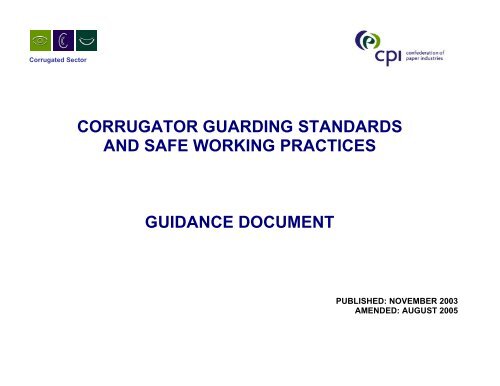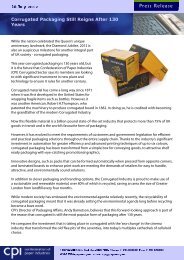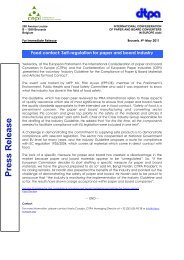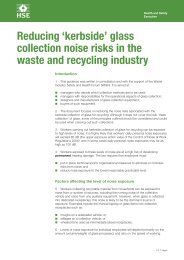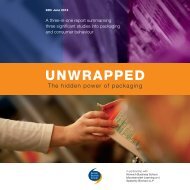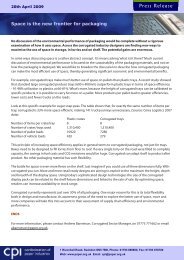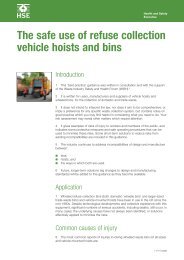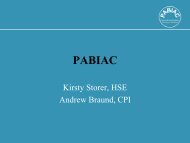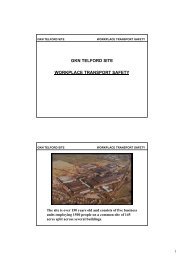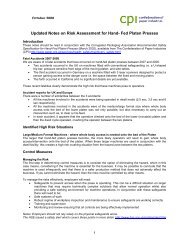Corrugator Guarding Standards and Safe Working Practices - CPI ...
Corrugator Guarding Standards and Safe Working Practices - CPI ...
Corrugator Guarding Standards and Safe Working Practices - CPI ...
Create successful ePaper yourself
Turn your PDF publications into a flip-book with our unique Google optimized e-Paper software.
Corrugated Sector<br />
CORRUGATOR GUARDING STANDARDS<br />
AND SAFE WORKING PRACTICES<br />
GUIDANCE DOCUMENT<br />
PUBLISHED: NOVEMBER 2003<br />
AMENDED: AUGUST 2005
<strong>Corrugator</strong> <strong>Guarding</strong> <strong>St<strong>and</strong>ards</strong> <strong>and</strong> <strong>Safe</strong> <strong>Working</strong> <strong>Practices</strong><br />
This inspection checklist is designed for member companies to use as a guide/aid to assess the adequacy of Machinery <strong>Guarding</strong> st<strong>and</strong>ards <strong>and</strong> safe<br />
working practices on their <strong>Corrugator</strong>.<br />
Forward by Health <strong>and</strong> <strong>Safe</strong>ty Executive<br />
This document will provide you with a useful <strong>and</strong> practical tool that you can use as a course filter for checking the safeguards of your corrugating<br />
machine. I welcome this <strong>CPI</strong> Corrugated Sector development <strong>and</strong> encourage you to make full use of the checklist. As well as helping you to find any<br />
gaps or shortcomings with existing safeguards <strong>and</strong> safety devices, it should assist you to identify some routine <strong>and</strong> non-routine tasks, such as<br />
threading up, cleaning, carrying out adjustments, engineering maintenance, clearing blockages <strong>and</strong> jams that have the potential for bringing operators<br />
<strong>and</strong> other staff into close proximity with moving parts of your machine. You should then carry out a detailed risk assessment for each of these activities<br />
<strong>and</strong> use the results to ensure that the relevant guards, safety devices <strong>and</strong> systems of work are designed in such a way as to ensure that the task will<br />
be carried out safely. Find out where your employees need to work on the machine, underst<strong>and</strong> what it is they need to do when they are there <strong>and</strong><br />
design the safeguards <strong>and</strong> procedures accordingly.<br />
Chris Flint<br />
HSE’s Manufacturing Sector<br />
September 2003<br />
Introduction by the <strong>CPI</strong> Corrugated Sector<br />
As an immediate practical tool, to assist the industry to address corrugator safety, the Corrugated Sector Health <strong>and</strong> <strong>Safe</strong>ty Committee has produced<br />
this <strong>Guarding</strong> <strong>St<strong>and</strong>ards</strong> <strong>and</strong> <strong>Safe</strong> <strong>Working</strong> <strong>Practices</strong> Checklist. It is intended for use as an inspection checklist to help audit corrugating machines.<br />
This process is expected to lead on to the conducting of Risk Assessment, which identify controls that deliver hazard reduction, <strong>and</strong> from the<br />
assessments the production of <strong>Safe</strong> Systems of Work; it does not replace these requirements. The Corrugated Sector <strong>Safe</strong>ty Recommendations (Pink<br />
Booklets) can provide guidance on hazard reducing controls, which need to be prioritised <strong>and</strong> approved through the appropriate budgeting processes.<br />
The <strong>Safe</strong> Systems of Work need to be easily understood by operators <strong>and</strong> produced for each unit or station of the machine. Finally the work<br />
undertaken needs to be translated into effective operator training that ensures the safe operation of the machine.<br />
<strong>CPI</strong> Corrugated Sector <strong>Guarding</strong> <strong>St<strong>and</strong>ards</strong> <strong>and</strong> <strong>Safe</strong> <strong>Working</strong> <strong>Practices</strong> – Inspection Checklist (August 2005) 2
The various types of machine guard available include:<br />
‣ Fixed guards – these are intended to prevent any part of the body coming into contact with dangerous parts. Fixed guards have no moving<br />
parts <strong>and</strong> are kept in place by welding or fasteners – it should only be possible to remove them by using a tool.<br />
‣ Distance guards – these are barriers sited at appropriate distances away from danger areas. Instead of completely enclosing danger areas,<br />
they place the danger areas out of normal reach.<br />
‣ Adjustable guards – these are guards, which are adjustable as a whole, or fixed with adjustable elements. The adjustment is made to suit the<br />
particular operation being carried out <strong>and</strong> remains fixed until it is completed. Operators should be trained in how to adjust them correctly so that<br />
maximum protection is gained.<br />
‣ Self-adjusting guards – these are fixed or movable guards which adjust automatically to accommodate the passage of material.<br />
‣ Fixed enclosing guards – these enclose the whole area of the dangerous machine so that the person is totally removed from the danger area.<br />
Openings in the guard exist so that work can be fed – automatically or manually – into the machine’s process.<br />
‣ Interlocking guards – these are guards, which are moveable or have moveable parts, whose movements is interconnected with the power or<br />
control system of the machine. The guard should be connected to these controls in two ways; firstly, until the guard is closed the power is shut<br />
off to prevent the machine from working. And secondly, the guard remains locked until the risk of injury has passed – or opening the guard<br />
eliminates the hazard, perhaps by shutting down the machine.<br />
‣ Electrosensitive Protection Equipment (ESPE) – trip systems that can be used as an alternative of interlocking guards.<br />
The hazards<br />
Dangerous parts of the machinery can cause a wide variety of injuries including:<br />
‣ Contact – serious injuries/amputation of limbs can occur after contact with rotating shafts/cylinders, e.g. Slitter Scorer unit or the Rotary Chop<br />
Unit <strong>and</strong> burns following contact with pre-heater/pre-conditioner rollers.<br />
‣ Entanglement – where clothes <strong>and</strong> hair or limbs can become entangled in unguarded revolving shafts, pulleys – causing serious injury.<br />
‣ In Running nip points – serious injuries/amputation of limbs can occur, e.g. between corrugator rolls <strong>and</strong> pressure rolls.<br />
‣ Impact – some parts of the corrugator can cause severe injury if an individual gets in the way when the machine is running at high speed.<br />
‣ The term ‘dangerous part of machinery’ is a well known one <strong>and</strong> the Health <strong>and</strong> <strong>Safe</strong>ty Executive has classified certain parts of machinery as<br />
inherently dangerous. These parts include revolving shafts, spindles, stock bars <strong>and</strong> abrasive wheels.<br />
‣ In view of this it is essential that we assess <strong>and</strong> remove the risks posed by these dangerous parts so that they do not cause injury.<br />
When assessing the need to guard one area it is important that you consider the type of guarding carefully, to ensure that the new guarding selected<br />
does not create another risk (e.g. ergonomically in the same area or risk further along the production process).<br />
<strong>CPI</strong> Corrugated Sector <strong>Guarding</strong> <strong>St<strong>and</strong>ards</strong> <strong>and</strong> <strong>Safe</strong> <strong>Working</strong> <strong>Practices</strong> – Inspection Checklist (August 2005) 3
Component: Hazard/Issue Identified: Findings: Action<br />
Required:<br />
Reel st<strong>and</strong>s<br />
While reels of paper are being loaded on <strong>and</strong> off the reel st<strong>and</strong>s or when paper is being<br />
spliced in, is there effective guarding or suitable systems around the reel st<strong>and</strong>s/Splicers,<br />
to prevent persons coming into contact with the reel or other moving parts?<br />
Electrosensitive Protection Equipment (ESPE) is a possible solution.<br />
Reel St<strong>and</strong>s<br />
Reel St<strong>and</strong>s<br />
Splicers<br />
Splicers<br />
Splicers<br />
Sound Proof Acoustic<br />
Enclosures<br />
Are there any exposed chains/sprockets, drive belts or rotating shafts, which are<br />
unguarded <strong>and</strong> have trap potential?<br />
Is there a safe system of work in case cores become jammed in the st<strong>and</strong> arm chucks to<br />
allow safe removal of reel?<br />
Are there any rotating parts within upper limb reach, which present an entanglement/nip<br />
hazard?<br />
Are there moving parts that can be a "struck by" or "shear " hazard. Are control<br />
measures in place to eliminate or minimise the risk? If so what are they?<br />
Where fixed guarding has been installed by the manufacturer, are all these guards<br />
securely fixed <strong>and</strong> in place?<br />
Are other guards securely fixed?<br />
Ensure all door catches on the unit have been fitted <strong>and</strong> are working?<br />
Are operators leaving doors open while the single Facer is running?<br />
Are all the doors <strong>and</strong> acoustic panels on the enclosures in place? Have any been<br />
damaged? It is critical to ensure that noise does not escape through any openings <strong>and</strong><br />
drastically reduce the effectiveness of the enclosure.<br />
Is correct signage in place?<br />
Hearing<br />
Protection<br />
Is suitable <strong>and</strong> effective hearing protection issued <strong>and</strong> the wearing made m<strong>and</strong>atory?<br />
Are m<strong>and</strong>atory warning notices displayed reinforcing the need to wear hearing protection<br />
around the corrugator?<br />
Has a noise assessment been conducted? Have any additional noise reduction<br />
measures been taken as a result of the noise assessment to reduce the levels?<br />
<strong>CPI</strong> Corrugated Sector <strong>Guarding</strong> <strong>St<strong>and</strong>ards</strong> <strong>and</strong> <strong>Safe</strong> <strong>Working</strong> <strong>Practices</strong> – Inspection Checklist (August 2005) 4
Component: Hazard/Issue Identified: Findings: Action<br />
Required:<br />
Pre Heater<br />
Are fixed guards or proximity guards fixed as appropriate?<br />
If interlocked gates are required do these reduce the machine to crawl speed or stop as<br />
appropriate?<br />
Single Facer<br />
Are control measures in place for threading paper through the single facer?<br />
Are procedures documented in a safe system of work <strong>and</strong> are operatives suitably trained<br />
<strong>and</strong> the training recorded?<br />
Single Facer<br />
Are drive shafts <strong>and</strong> other dangerous rotating parts fully guarded at the drive side of the<br />
Facer?<br />
Is this guarding suitable <strong>and</strong> sufficient to prevent anyone being able to reach in or climb<br />
over the guard? (A guard which is 2 metres in height with an interlocking access gate<br />
connected to the power/control unit or fixed guard)<br />
Pre Heater/Single Facer<br />
Single Facer<br />
Single Facer<br />
Do operators wear special gloves <strong>and</strong> sleeves to protect themselves from contact with<br />
heated rollers/cylinders?<br />
Are there panels covering all dangerous rotating parts? How are these panels secured?<br />
(Locks/padlocks or are they interlocked to the single Facer or ideally, interlocked to the<br />
power/control panel)<br />
If operators walk through the single Facer unit between the corrugator rolls/pressure rolls<br />
<strong>and</strong> the pre heater while the machine is running at greater than crawl speed – are<br />
suitable proximity guards in place?<br />
What guarding arrangements are there in place around the corrugator roller <strong>and</strong><br />
pressure roller, to protect persons from the serious in running nip point?<br />
Possibly interlocking gates at either end preventing persons from being able to access<br />
the rollers while the machine is running at speed. Access through only allowed while<br />
threading paper through when the machine is at crawl speed. (5 linear metres per<br />
minute)<br />
<strong>CPI</strong> Corrugated Sector <strong>Guarding</strong> <strong>St<strong>and</strong>ards</strong> <strong>and</strong> <strong>Safe</strong> <strong>Working</strong> <strong>Practices</strong> – Inspection Checklist (August 2005) 5
Component: Hazard/Issue Identified: Findings: Action<br />
Required:<br />
Single Facer<br />
Prior to conducting any cleaning tasks within the single facer, have suitable <strong>and</strong> sufficient<br />
risk assessments been prepared outlining existing control measures? Are the control<br />
measures documented in safe systems of work? Is there a defined cooling down period,<br />
prior to cleaning down heated rollers <strong>and</strong> cylinders?<br />
Single Facer<br />
<strong>Working</strong> at height. See note under other issues on last page<br />
During engineering or cleaning maintenance, is there a requirement to work at height<br />
(above 2 metres), if so what control measures are in place to protect persons? E.g. a<br />
suitable working platform securely fenced on the open sides <strong>and</strong> accessible by fixed<br />
steps or ladder or, as a last resort lanyard <strong>and</strong> harness.<br />
Single Facer Are all steam pipes lagged to prevent burn hazards <strong>and</strong> to save heat?<br />
Single Facer<br />
Wrap Arms – within the single<br />
facer – ground <strong>and</strong> gantry level<br />
Is there adequate drainage around the single facer to allow effective run off of water, to<br />
eliminate STF hazards?<br />
Is there any guarding around these wrap arms to prevent persons being entangled with<br />
the cylinders?<br />
Overhead Gantry<br />
Between single facers <strong>and</strong><br />
gantry to the double backer<br />
Does the gantry have the required guard rails, mid point rails <strong>and</strong> toe boards fitted along<br />
the full length of the machine?<br />
Is every section of the platform secure with no loose boarding or gaps in it?<br />
Overhead Gantry Are there any STF hazards on the platform?<br />
Overhead Gantry<br />
Gantry/transfer sections<br />
between single Facer’s/double<br />
backer<br />
Is the area under the transfer section where the paper is travelling through boarded out<br />
to ensure no risk of anyone falling through the web to the floor area below?<br />
Are there any exposed rollers/shafts/belts or any in running nip points along the<br />
overhead section where persons could get entangled?<br />
Are operators allowed to be on the gantry while the machine is running at greater than<br />
crawl speed (9 linear meters per minute)? If so, what precautions are in place?<br />
<strong>CPI</strong> Corrugated Sector <strong>Guarding</strong> <strong>St<strong>and</strong>ards</strong> <strong>and</strong> <strong>Safe</strong> <strong>Working</strong> <strong>Practices</strong> – Inspection Checklist (August 2005) 6
Component: Hazard/Issue Identified: Findings: Action<br />
Required:<br />
Gantry Is there a safe system of work for clearing/removing single face web from the gantry?<br />
Fixed stairs or ladders to the<br />
overhead gantry<br />
Are these stairs or ladders firmly secured to the floor <strong>and</strong> gantry?<br />
Do they have any h<strong>and</strong>rails on them?<br />
Double Backer – Pre Heater Is the pre heater section/wrap arms fully guarded around the Double Backer unit with a 2<br />
metre fixed guard with an interlocking sliding gate at the front <strong>and</strong> a further gate at the<br />
side of the unit on both sides of the machine to prevent access into the unit while the<br />
machine is running at greater than crawl speed. The side gate to be interlocked so the<br />
gate will not open until the machine speed is a 9 linear meters per minute (Crawl Speed)<br />
to thread paper through only?<br />
Double Backer<br />
If there is a panel which covers/guards exposed dangerous rotating parts at this point, is<br />
this panel firmly secured? How is it secured?<br />
Locked or interlocked?<br />
Overhead Gantry above the<br />
Double Backer<br />
Gantry feeding the Web to the<br />
Glue Unit<br />
If there is a walkway/platform above the unit, is this walkway fully guarded with guard<br />
rails, mid point rails <strong>and</strong> toe boards <strong>and</strong> meshed or boarded underneath to prevent<br />
anyone falling from the platform into the double backer/glue unit <strong>and</strong> being carried<br />
forward into the blanket section?<br />
Is there suitable provision for feeding the single face web from the gantry to the glue<br />
unit?<br />
Is the walkway/platform adequate to ensure safe working at height?<br />
Has suitable access to this area been provided?<br />
Tessa Tape Unit<br />
Normally the tape is inserted from the drive side.<br />
Does it move in safely without obstruction that could cause it to jam, skew or stop<br />
suddenly?<br />
Is there a safe method for feeding Tessa tape into the web?<br />
Is there any requirement for persons to work at height (e.g. to change tape)?<br />
<strong>CPI</strong> Corrugated Sector <strong>Guarding</strong> <strong>St<strong>and</strong>ards</strong> <strong>and</strong> <strong>Safe</strong> <strong>Working</strong> <strong>Practices</strong> – Inspection Checklist (August 2005) 7
Component: Hazard/Issue Identified: Findings: Action<br />
Required:<br />
Tessa Tape Unit<br />
What impact does the insertion of the unit have on any gates <strong>and</strong> interlocking provided<br />
between the glue unit <strong>and</strong> the blanket section?<br />
Glue Unit/entry to blanket<br />
section or short press<br />
depending on the machine<br />
Is there a suitable access gate on both sides of the machine at this point, interlocked to<br />
the machine <strong>and</strong> incapable of being opened unless the machine speed has fallen to a<br />
crawl speed of 5 linear meters per minute? This gate to be a minimum of 2 metres in<br />
height.<br />
The in running nip point on entry to the blanket section must be fully guarded <strong>and</strong><br />
protected.<br />
Blanket Section/ Shortpress<br />
Is the blanket section guarded on both sides of the machine?<br />
Are the actual panels at the side <strong>and</strong> below the unit secured?<br />
How are they secured? Fixed or interlocked?<br />
Or<br />
Is there perimeter fencing running the entire length of the machine on both sides,<br />
keeping persons away from the unit while it is operational?<br />
If there is perimeter fencing, does this guarding incorporate an interlocking access gate<br />
with a key exchange system in place?<br />
Or<br />
Is there ESPE (light guarding) preventing access to the blanket section <strong>and</strong> under the<br />
unit while the machine is running<br />
Blanket Section/Shortpress What safe operating procedures do you have in place for :-<br />
1. Getting up on the Blanket section for cleaning or maintenance<br />
2. Cleaning the Short press units?<br />
What method of access on <strong>and</strong> off the blanket section is provided?<br />
Do these procedures include the method <strong>and</strong> requirements for isolation?<br />
<strong>CPI</strong> Corrugated Sector <strong>Guarding</strong> <strong>St<strong>and</strong>ards</strong> <strong>and</strong> <strong>Safe</strong> <strong>Working</strong> <strong>Practices</strong> – Inspection Checklist (August 2005) 8
Component: Hazard/Issue Identified: Findings: Action<br />
Required:<br />
Rotary Shear Unit<br />
Is the drive roller adequately guarded on both sides of the machine?<br />
Has access been prevented to stop a person climbing over the drive roller to gain access<br />
to the blanket?<br />
Are there any exposed shafts; belts within easy upper limb reach either side of the drive<br />
roller?<br />
Rotary Shear Unit<br />
Where reject board is being discharged into a trolley/cage, is there an interlocking<br />
access gate in front of the unit to prevent access into the unit while the machine is<br />
running?<br />
This gate can only be opened when the machine is not chopping out waste board.<br />
Alternatively has a chute been installed that diverts the reject board into a trolley cage<br />
that is located under a non-hazardous part of the machine?<br />
Ripper Tape Unit<br />
Where the Ripper Tape applicator is positioned is there a safe working platform to st<strong>and</strong><br />
on while attending to the process?<br />
Does this safe working platform have guard rails, mid point rails toe boards <strong>and</strong> is it fully<br />
in filled to prevent anyone falling off the unit onto the web, which would carry a person to<br />
the slitter scorer unit?<br />
Rotary Shear Unit leading to<br />
the Slitter Scorer Unit<br />
What level of guarding is in place between these units?<br />
Is there easy access to any dangerous moving parts?<br />
Can a person walk under the unit, crossing from one side of the machine to the other?<br />
Ideally both sides o this section should have fixed guarding, 2 metres in height with an<br />
interlocking access gate on both sides, if necessary<br />
<strong>CPI</strong> Corrugated Sector <strong>Guarding</strong> <strong>St<strong>and</strong>ards</strong> <strong>and</strong> <strong>Safe</strong> <strong>Working</strong> <strong>Practices</strong> – Inspection Checklist (August 2005) 9
Component: Hazard/Issue Identified: Findings: Action<br />
Required:<br />
Slitter Scorer Unit<br />
Is the entry point to the slitter scorer unit adequately guarded on both sides of the<br />
machine, preventing persons from being able to reach into the slitter/creaser shafts?<br />
Is the area immediately in front of the shafts guarded the full width of the unit/machine?<br />
Is there a gate at this point, providing entry to the unit for clearing jam-ups or<br />
adjustments?<br />
If so, how is this gate secured? This gate should be interlocked to the machine with a<br />
key exchange system in place<br />
Slitter Scorer Unit<br />
Is there a pit under the slitter scorer unit?<br />
Where are the access points to this pit?<br />
Are the access points, (gates, trap doors) interlocked to the machine?<br />
Is access to the pit restricted to authorised persons only?<br />
Are there safe operating procedures or SSoW in place for entering the pit <strong>and</strong> working<br />
on the unit?<br />
Is the area defined as a confined space?<br />
If it is a confined space area, are permits to work used?<br />
Slitter Scorer Unit<br />
Is there any other dangerous part on the unit where access is easily obtained <strong>and</strong> there<br />
is no guarding in place to protect persons from the exposed parts?<br />
Slitter/Scorer Unit Is the discharge area from the unit adequately guarded on both sides of the machine?<br />
Slitter Scorer Unit leading to<br />
the Rotary Chop Unit<br />
Is the transfer section guarded on both sides of the machine, preventing access under<br />
the unit?<br />
Are there any finger/h<strong>and</strong> traps on the transfer section?<br />
Can access be obtained on to the web?<br />
Could a person enter on to the web <strong>and</strong> be carried forward into the rotary chop unit?<br />
Is there an interlocking access gate, preventing persons getting on to the web while the<br />
machine is running?<br />
<strong>CPI</strong> Corrugated Sector <strong>Guarding</strong> <strong>St<strong>and</strong>ards</strong> <strong>and</strong> <strong>Safe</strong> <strong>Working</strong> <strong>Practices</strong> – Inspection Checklist (August 2005) 10
Component: Hazard/Issue Identified: Findings: Action<br />
Required:<br />
Rotary Chop Unit<br />
Is the entry point to the unit (rotating shaft/knife) adequately guarded the full width of the<br />
machine?<br />
How is this unit guarded?<br />
Rotary Chop Unit<br />
Are there safe systems of work in place for performing engineering work on the unit <strong>and</strong><br />
are there safe procedures to be followed when clearing jam ups?<br />
Is access into this unit controlled via a permit to work system?<br />
Is the discharge point from the unit adequately guarded?<br />
Can a person reach back into the unit <strong>and</strong> make contact with the rotating shaft/knife?<br />
Top Stacker transfer section<br />
Can persons walk on <strong>and</strong> off the transfer conveyor belt freely at any time?<br />
If so what procedures are in place?<br />
Are appropriate emergency stop trip wires provided <strong>and</strong> set at an effective height?<br />
Is the section securely fenced on both sides?<br />
Is there a gate (entry point) onto the conveyor line, which is interlocked restricting access<br />
when the machine is running at greater than crawl speed?<br />
If the operator has to lean over to take samples are suitable h<strong>and</strong> rests for supporting the<br />
arm provided?<br />
Is there a safe working platform or bridge across the machine for persons to st<strong>and</strong> on?<br />
Top/Bottom Stacker transfer<br />
section<br />
Top/Bottom Stacker transfer<br />
section<br />
Are there any exposed in running nip points along the section?<br />
Are there any exposed shafts/rollers/chains along the section?<br />
Is access prevented from under the belt section while belts are operational?<br />
Are there any exposed shafts/rollers where a person could get entangled?<br />
Is this area fenced off or adequately guarded?<br />
<strong>CPI</strong> Corrugated Sector <strong>Guarding</strong> <strong>St<strong>and</strong>ards</strong> <strong>and</strong> <strong>Safe</strong> <strong>Working</strong> <strong>Practices</strong> – Inspection Checklist (August 2005) 11
Component: Hazard/Issue Identified: Findings: Action<br />
Required:<br />
Stacker Lift Tables<br />
Is the area around the lift tables fully guarded, the height, width <strong>and</strong> length of the unit,<br />
completely preventing persons from being under the lift table while it is operational?<br />
Are locking off pins always used when access under the stacker for engineering or<br />
cleaning maintenance is required? These pins securing the lift table in the event of<br />
hydraulic failure.<br />
Is there a safe system of work in place for entering under the stacker lift tables?<br />
Does this system of work require a check to be performed to confirm that the locking off<br />
pins have been put in place before entry under the stacker unit is allowed?<br />
Delivery Conveyor<br />
Are there any exposed shafts/rollers/chains along the section?<br />
Are there any in running nip points along the section that are unguarded?<br />
Either in running nip points in powered conveyors or stack tracking?<br />
Is the out feed line split into sections?<br />
Can each section be individually driven in both directions to bring stacks of board<br />
together?<br />
Can this line operate in manual <strong>and</strong> automatic mode?<br />
Are persons allowed on the unit, when the rollers/track are operating in<br />
manual/automatic mode?<br />
Are there procedures to ensure that the line is isolated prior to persons walking on the<br />
line, to attend to stacks fallen over etc?<br />
What method of isolation is used for this task?<br />
Does the operator walk on to the line to insert identification tickets or can this task be<br />
carried out, without the need for a person to have to go on to the line?<br />
<strong>CPI</strong> Corrugated Sector <strong>Guarding</strong> <strong>St<strong>and</strong>ards</strong> <strong>and</strong> <strong>Safe</strong> <strong>Working</strong> <strong>Practices</strong> – Inspection Checklist (August 2005) 12
Component: Hazard/Issue Identified: Findings: Action<br />
Required:<br />
OTHER ISSUES<br />
Electrical – throughout the<br />
machine<br />
Hydraulic oil tanks/pipe work<br />
How many start positions are there on the machine?<br />
Where are these located?<br />
Can the machine be re-set from all these positions?<br />
Does re-setting the machine, involve the use of a key?<br />
Are keys removed from the reset buttons so no person is able to reset the machine<br />
whilst individuals are in a potentially harmful position<br />
Is there a unique key at each re set position?<br />
Are there authorised persons who have the responsibility for re setting the machine?<br />
Is the isolation procedure defined <strong>and</strong> understood by all persons?<br />
Are there different levels of isolation depending on what tasks/activities are being carried<br />
out?<br />
Does the machine operate with a key exchange system?<br />
Do all the emergency stops/interlocks on the machine fail to safe?<br />
Are emergency stops on a dual circuit system<br />
Is the electrical relay system fitted to the machine of a switch type (e.g. Pilz Relay)?<br />
Are all emergency stops <strong>and</strong> interlocking guards checked on a regular basis?<br />
Have these safety checks been defined specifying what must be checked/inspected,<br />
every shift, daily, weekly etc?<br />
Are there any oil leaks on any of the tanks?<br />
Are the tanks <strong>and</strong> pipe work regularly inspected?<br />
<strong>Working</strong> at height (throughout<br />
the machine)<br />
Have controls been put in place that adhere to the Work at Height hierarchy?<br />
These are: 1. Avoid work at height where possible, 2. use work equipment or other<br />
measures to prevent falls where cannot avoid working at height 3. where a fall cannot be<br />
eliminated use work equipment or other measures to minimise potential distance <strong>and</strong><br />
consequence of a fall.<br />
<strong>CPI</strong> Corrugated Sector <strong>Guarding</strong> <strong>St<strong>and</strong>ards</strong> <strong>and</strong> <strong>Safe</strong> <strong>Working</strong> <strong>Practices</strong> – Inspection Checklist (August 2005) 13
<strong>Corrugator</strong> <strong>Guarding</strong><br />
Blanket Press 1<br />
Fence with interlocked gates<br />
Double Backer Glue Unit 1<br />
Fence with interlocked gates<br />
Double Backer Glue Unit 2<br />
Interlocked Gates<br />
Double Backer Glue Unit to<br />
Blanket Press<br />
Double Backer 1<br />
<strong>Guarding</strong> all entry points<br />
Blanket Press 2<br />
Fence with interlocked gates<br />
ESPE on Reel St<strong>and</strong> 1 ESPE on Reel St<strong>and</strong> 2<br />
<strong>CPI</strong> Corrugated Sector <strong>Guarding</strong> <strong>St<strong>and</strong>ards</strong> <strong>and</strong> <strong>Safe</strong> <strong>Working</strong> <strong>Practices</strong> – Inspection Checklist (August 2005) 14
<strong>Corrugator</strong> <strong>Guarding</strong><br />
ESPE on Reel St<strong>and</strong> 3 ESPE on Reel St<strong>and</strong> 4 ESPE Reel on St<strong>and</strong> 5 ESPE on Reel St<strong>and</strong> 6<br />
Rotary Shear 1, Conveyor<br />
diverting reject board to cage<br />
Rotary Shear 2, Conveyor diverting reject<br />
board to cage (different angle)<br />
Rotary Shear 3<br />
Interlocked guarding for cage<br />
Rotary Shear 4<br />
Interlocked guarding<br />
<strong>CPI</strong> Corrugated Sector <strong>Guarding</strong> <strong>St<strong>and</strong>ards</strong> <strong>and</strong> <strong>Safe</strong> <strong>Working</strong> <strong>Practices</strong> – Inspection Checklist (August 2005) 15


